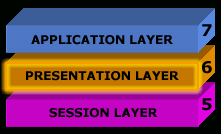OSI Layer 6 - Presentation Layer

There are no protocols which work specificly at the Presentation layer, but the protocols which work at the Application layer are said to work on all 3 upper layers.
The Presentation Layer gets its name from its purpose: It presents data to the Application layer. It's basically a translator and provides coding and conversion functions. A successful data transfer technique is to adapt the data into a standard format before transmission. Computers are configured to receive this generically formatted data and then convert the data back into its native format for reading. By providing translation services, the Presentation layer ensures that data transferred from the Application layer of one system can be read by the Application layer of another host.
The OSI has protocol standards that define how standard data should be formatted. Tasks like data compression, decompression, encryption and decryption are associated with this layer. Some Presentation layer standards are involved in multimedia operations. The following serve to direct graphic and visual image presentation :
JPEG: The Joint Photographic Experts Group brings these photo standards to us.
MIDI: The Musical Intrument Digital Interface is used for digitized music.
MPEG: The Moving Pictures Experts Group's standard for the compression and coding of motion video for CD's is very popular.
QuickTime: This is for use with Machintosh or Power PC programs, it manages audio and video applications.
